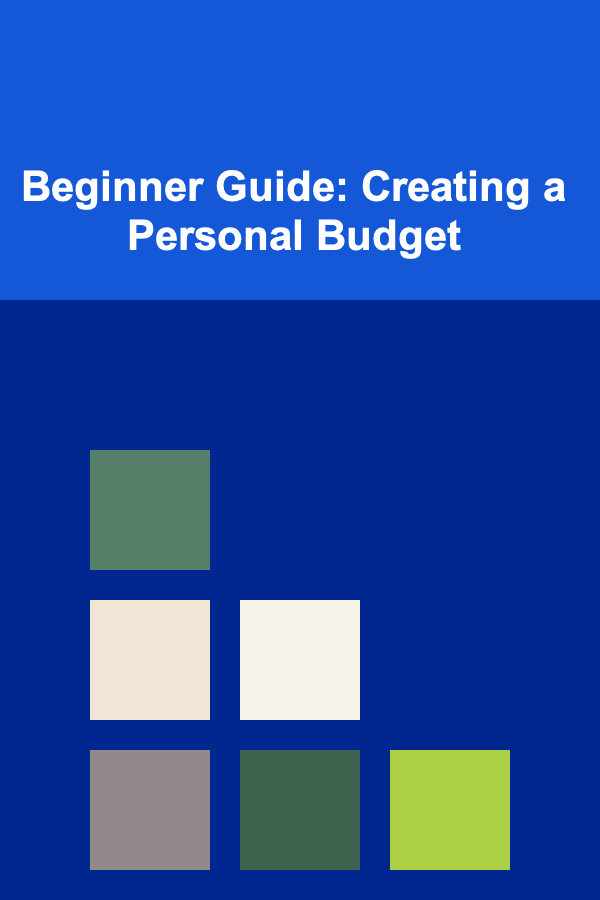
Beginner Guide: Creating a Personal Budget
ebook include PDF & Audio bundle (Micro Guide)
$12.99$8.99
Limited Time Offer! Order within the next:

Creating a personal budget can be a game-changer in achieving financial stability and meeting your financial goals. Whether you're aiming to save for an emergency fund, pay off debt, or simply manage your expenses more effectively, having a budget in place is the first step toward making your financial dreams a reality. In this beginner guide, we'll walk you through the steps of creating a personal budget, offer actionable tips, and address common pitfalls to avoid. Let's dive in.
Understanding Why Budgeting Matters
Before we start crafting your budget, it's important to understand why budgeting is crucial. A personal budget acts as a roadmap for your finances. It gives you control over your money, helping you prioritize your spending and saving.
The key benefits of budgeting include:
- Tracking Income and Expenses: By tracking your income and expenses, you'll have a clear understanding of where your money is going.
- Financial Control: Budgeting allows you to control your finances instead of letting them control you. It helps you avoid overspending and falling into debt.
- Achieving Financial Goals: Whether it's saving for a vacation, buying a home, or paying off debt, budgeting helps you prioritize and achieve your financial goals.
Assess Your Current Financial Situation
The first step in creating a personal budget is understanding your current financial picture. This involves gathering data on your income and expenses to see where your money is coming from and where it's going. Here's how to start:
a. Calculate Your Income
Begin by identifying all sources of income. This includes your primary job, side gigs, freelance work, investments, or any other recurring sources of income. You'll want to focus on your net income (the amount you take home after taxes and deductions) rather than gross income, as this is what you have available to spend.
For example:
- Job Salary: $3,500/month (after tax)
- Side Gigs/ Freelance Work: $500/month
- Rental Income: $1,000/month
Total Monthly Income: $5,000
b. Track Your Expenses
Next, track your monthly expenses. Expenses are usually divided into two main categories:
-
Fixed Expenses: These are regular and predictable expenses that don't change from month to month. Examples include:
- Rent or mortgage
- Car payment
- Insurance premiums
- Subscriptions (Netflix, gym memberships, etc.)
-
Variable Expenses: These fluctuate from month to month, and include:
- Groceries
- Utilities (electricity, gas, etc.)
- Transportation (gas, public transport)
- Dining out
- Entertainment and leisure
c. Use Budgeting Tools
If you're struggling to track your expenses manually, you can use apps or spreadsheets to make the process easier. Some popular budgeting tools include:
- Mint: A free budgeting app that connects to your bank accounts and tracks your spending automatically.
- YNAB (You Need a Budget): A paid app that helps you assign every dollar to a specific category.
- Personal Spreadsheet: If you prefer hands-on tracking, a Google Sheets or Excel spreadsheet works well for manual tracking.
Categorize Your Expenses
Once you've tracked your expenses for a few months, categorize them into essential and non-essential categories:
- Essential expenses are necessary for daily living and include things like rent, utilities, groceries, insurance, and transportation.
- Non-essential expenses are things you can cut back on if needed, such as dining out, entertainment, or impulse purchases.
Having a clear distinction between essential and non-essential expenses helps you identify areas where you can potentially save money.
Set Realistic Budgeting Goals
Now that you have a full picture of your income and expenses, it's time to set realistic budgeting goals. These goals will guide your decisions and help you stay on track. Common budgeting goals might include:
- Building an emergency fund: Aim to save 3-6 months of living expenses to cover unexpected costs (such as medical bills, car repairs, or job loss).
- Paying off debt: Focus on eliminating high-interest debts (such as credit cards) while managing lower-interest debts (like student loans or mortgages).
- Saving for a large purchase: If you're planning to buy a home, car, or go on a vacation, set aside a portion of your income toward that goal.
SMART Goals
To ensure that your goals are achievable, apply the SMART goal framework. SMART goals are:
- Specific: Clearly define what you want to achieve.
- Measurable: Make sure your goal is quantifiable (e.g., "I want to save $1,000 in the next 6 months").
- Achievable: Set a goal that is realistic given your current situation.
- Relevant: Ensure the goal aligns with your overall financial priorities.
- Time-bound: Set a deadline for achieving your goal.
Create the Budget
Now that you have a clear understanding of your income, expenses, and goals, it's time to create your actual budget. There are several budgeting methods, but the most popular ones are the 50/30/20 rule and the Zero-based budget. Here's how each method works:
a. 50/30/20 Rule
This rule is simple and easy to follow, especially for beginners. The idea is to divide your income into three broad categories:
- 50% Needs: Allocate 50% of your income to essential expenses like housing, utilities, and groceries.
- 30% Wants: Allocate 30% of your income to non-essential expenses like dining out, entertainment, or shopping.
- 20% Savings & Debt Repayment: Allocate 20% of your income to savings (emergency fund, retirement) and debt repayment.
For example, if your monthly income is $5,000, your budget might look like this:
- Needs (50%): $2,500
- Wants (30%): $1,500
- Savings & Debt (20%): $1,000
b. Zero-Based Budgeting
Zero-based budgeting gives every dollar a purpose. At the end of the month, your income minus your expenses should equal zero. This method is best for those who want a more detailed breakdown of their spending and prefer to allocate money to every category, including savings, investments, and debt repayment.
For example, if your income is $5,000:
- Rent: $1,200
- Utilities: $300
- Groceries: $400
- Transportation: $200
- Savings: $600
- Debt Repayment: $500
- Entertainment: $200
The total for all categories should equal $5,000. Each dollar is assigned to a specific purpose, leaving no money "unaccounted for."
Track and Adjust Regularly
Once you've created your budget, the next step is to track your spending throughout the month. This allows you to see if you're staying within your limits or need to make adjustments.
a. Weekly Check-ins
Review your budget at least once a week to ensure that you're staying on track. If you're over-spending in one category, try to cut back in another.
b. Make Adjustments
Your first budget will likely need tweaking. If you find you're consistently overspending in a category, adjust your allocations to make your budget more realistic. Similarly, if you've saved more than expected in one area, you can redirect that extra money toward savings or debt repayment.
Overcoming Common Budgeting Challenges
Budgeting can be difficult, especially if you're new to it. Here are a few common challenges and how to overcome them:
- Unexpected Expenses: Life happens. You'll encounter unexpected expenses like car repairs or medical bills. Build a buffer into your budget by setting aside money in a "miscellaneous" category or increasing your emergency fund.
- Impulse Purchases: To curb impulsive spending, avoid temptation by leaving your credit cards at home or setting up a cooling-off period before making non-essential purchases.
- Sticking to the Budget: Stay motivated by regularly reviewing your financial goals and celebrating small victories along the way. You may also find it helpful to set up automatic transfers to your savings account so you don't forget to save.
Conclusion
Creating a personal budget is an empowering step toward achieving financial health and independence. By assessing your income and expenses, setting realistic goals, and consistently tracking your spending, you can take control of your finances. Remember, budgeting is a dynamic process---it's okay to adjust and refine your plan as life changes. The key is to get started and stay committed to your financial future.
Reading More From Our Other Websites
- [Home Pet Care 101] How to Get a Cat to Drink More Water
- [Personal Care Tips 101] How to Choose the Best Toothpaste for Whitening Sensitive Teeth
- [Personal Financial Planning 101] How to Budget for Irregular Income as a Freelancer
- [Home Storage Solution 101] How to Keep Your Furry Friend's Gear Organized: Clever Storage for Pet Supplies That Blends with Your Decor
- [Personal Financial Planning 101] How to Understand the Difference Between Saving and Investing
- [Home Holiday Decoration 101] How to Incorporate Holiday Scent Ideas in Your Home
- [Horseback Riding Tip 101] Best Winter Riding Gear to Keep Both Rider and Horse Warm in Sub‑Zero Conditions
- [Home Storage Solution 101] How to Tidy Up Your Home With the Right Storage Baskets
- [Personal Investment 101] Turning Your Deep Learning Projects into Money-Making Opportunities
- [Home Rental Property 101] How to Inspect Houses for Rent with a Fireplace for Potential Safety Hazards Before Signing a Lease

How to Budget for a Pet-Friendly Home Without Overspending
Read More
How to Manage Your Debt Efficiently with a Debt Repayment Plan
Read More
How to Soundproof Your Apartment Without Landlord Approval
Read More
How To Develop a Strong Sense of Self-Worth
Read More
How to Ace Your Government Job Application Checklist
Read More
How to Edit Drone Footage in Premiere Pro
Read MoreOther Products

How to Budget for a Pet-Friendly Home Without Overspending
Read More
How to Manage Your Debt Efficiently with a Debt Repayment Plan
Read More
How to Soundproof Your Apartment Without Landlord Approval
Read More
How To Develop a Strong Sense of Self-Worth
Read More
How to Ace Your Government Job Application Checklist
Read More